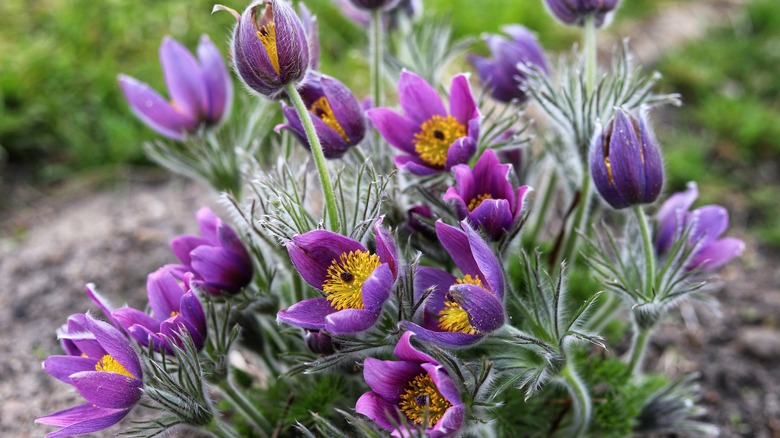Tips For Growing Stunning Pasqueflowers To Add A Splash Of Purple To Your Yard
As a member of the Buttercup family, pasqueflower (Pulsatilla vulgaris) adds unique visual interest to any flower garden with its whimsical goblet-shaped blooms. This flower thrives in the springtime and is native to northern European countries like Denmark and Norway. To add a pop of purple to your own garden using pasqueflower, it's important to carefully select the best location for the flowers and to maintain them throughout the seasons with pest protection and proper watering.
With stalks ranging in height from five to eight inches, these showy flowers are sure to catch the eye. This species is an especially smart option if local bunnies have a history of chewing up your blooms, since rabbits won't bother this addition to your flower garden. While beautiful, pasqueflower does come with an important caveat: most parts of this plant are toxic to humans, livestock, and pets. The protoanemonin in this plant can cause pain, swelling, and blistering in the mouth, and can result in stomach upset and vomiting. If you have particularly curious pets who love to chomp on anything within reach, this may not be the best species for your garden. If you do decide to move forward and plant pasqueflower, be careful not to come in contact with the sap since it can cause skin irritation.
Choose the right spot and soil for pasqueflowers
The most important factor in growing thriving pasqueflowers is selecting an area with the correct amount of sun and ideal soil. Pasqueflowers are perennial plants that are hardy in USDA agricultural zones 4 through 8, meaning that they thrive best in cooler climates. You can find a spot in your garden that gets full sun and grow the flower from seed, but be aware that you may not see these flowers fully bloom for a couple of years while the plant gets established. You could also opt to transplant a bare root plant in early spring or during the fall.
You can plant pasqueflower alongside flowering bulbs or ground cover, as long as your chosen location has well-drained soil and plenty of sunlight. Pasqueflower doesn't tolerate wet soil well, so drainage is a must, especially if you live in a wet climate. Plant these alongside other flowers that'll attract bees and pollinators to your garden, since pollination will help pasque flowers to thrive and propagate. If you're aiming for a specific color scheme among your garden blooms, there are several different color varieties of this plant, ranging from white to red.
Maintaining and propagating healthy pasqueflowers
In cool climates and well-draining soil, pasqueflowers don't require much maintenance. There's no need for heavy fertilizing, and once these plants are established, you won't need to water them more than once a week. While pasqueflower does a great job keeping bunnies away, deer do like to munch on these purple blooms. If these adorable mammals like to frequent your yard, you may need to take steps to stop deer from snacking on your pasqueflowers. Build exclosures with cattle panels, or grow repellent plants like marigolds nearby.
To propagate and spread your collection of pasqueflowers, you can allow your existing plants to reseed or you can divide a mature plant into up to six new plants. Before dividing or moving this plant, it's best to cut back the existing flowers and buds. If you're transplanting an existing plant, be careful not to disturb the roots too much. On the flip side, if you want to prevent these blooms from spreading too much or if you're uncertain of final placement, you can also grow pasqueflower in containers with good drainage. They'll need slightly more frequent watering in containers and will grow best in soil amended with compost.


